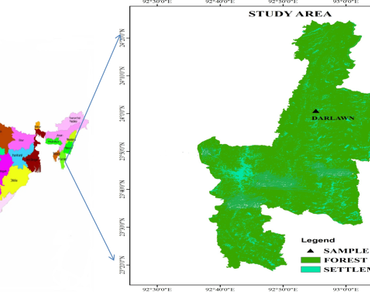Aboveground biomass and carbon stock estimation of Melocalamus compactiflorus (Kurz) Benth.: a climbing bamboo of Northeast India
Short Communications | Published: 02 November, 2022
First Page: 1544
Last Page: 1549
Views: 3460
Keywords: Branch, Climbing, Culm, Sympodial, Litter
Abstract
Tropical forests play important role in global carbon cycle and mitigating of global warming through carbon sequestration. Data on carbon stock and sequestration of bamboo species are relatively less focused than other many woody plants. We aimed to study aboveground biomass and carbon stock of three age class (1, 2 and ≥ 3 year) of Melocalamus compactiflorus (Kurz) Benth. using harvest method. Carbon stock was determined from the culm density drawn from requisite number of sample quadrates. Significant variations with respect to culm age were observed in bamboo forests. The ≥ 3 year age class exhibited highest contribution to total culm density. The average culm density was 11,457 culms ha−1 and average DBH and thickness of the culms were 2.14 cm and 4.5 mm respectively. The branch component contributed maximally (48.6%) to total aboveground biomass than the culm component (32.4%) leading to a reduced role of DBH in aboveground biomass. The aboveground biomass carbon stock of M. compactiflorus in the present study ranged from 17.18 to 44.63 Mg C ha−1 with a sequestration rate as high as 27.59 Mg C ha−1 year−1 demonstrating this species as an excellent carbon capture species for forest restoration and climate change mitigation initiatives.

References
Ahirwal J, Nath A, Brahma B, Deb S, Sahoo UK, Nath AJ (2021) Patterns and driving factors of biomass carbon and soil organic carbon stock in the Indian Himalayan region. Sci Total Environ 770:145292. https://doi.org/10.1016/j.scitotenv.2021.145292
Amoa M, Assan F, Dadzei PK (2020) Aboveground biomass, carbon storage and fuel values of Bambusa vulgaris, Oxynanteria abbyssinica and Bambusa vulgaris var. vitata plantations in the Bobiri Forest Reserve of Ghana. J Sustain Forest 39(2):113–136. https://doi.org/10.1080/10549811.2019.1608452
Bamboo Development Agency (2008) Bamboo in Mizoram, Government of Mizoram
Banik RL (2000) Silviculture and field-guide to priority bamboos of Bangladesh and South Asia. Government of the People’s Republic of Bangladesh, Forest Research Institute, Chittagong, p 187
Banik RL (2016) Silviculture of South Asian priority bamboos. Springer, Berlin, pp 203–207
Devi AS, Singh KS (2021) Carbon storage and sequestration potential in aboveground biomass of bamboos in North East India. Sci Rep 11:837
Devi AS, Sahoo UK, Mishra BP, Singh KS (2021) Carbon stock and carbon sequestration in aboveground biomass of muli bamboo at different altitudes in North-East India. Indian J Environ Prot 41:557–561
Houba V, Vander Lee J, Novozamsky I, Wallinga I (1989) Soil and plant analysis. A series of syllabi part 5: soil analysis procedures, 4th edn, Wageningen, Netherlands
INBAR (2016) International network for bamboo and rattan. Indo-German Project climate change adaptation in Northeast India. In: Proceeding on bamboo perspectives in Mizoram and the northeast India, Department of Environment and Forests, and Climate Change, Government of Mizoram
IPCC (2003) IPCC good practice guidance for LULUCF sector. Intergovermental panel on climate change. Cambridge University Press, Cambridge
IPCC (2007) Climate change: synthesis report, contribution of working groups I, II, and II to the fourth assessment report of the Intergovermental Panel on Climate Change, Geneva, Switzerland
Isagi Y, Kawahara T, Kamo K, Ito H (1997) Net production and carbon cycling in a bamboo Phyllostachys pubescens stand. Plant Ecol 130:41–52
Mohamed J, Hamid HA, Niruddin AA, Majid NMNA (2019) Chemical attribute of Gigantochloa scortechinii bamboo rhizome in relation with hydraulic conductance. BioResources 14:8155–8173
Nath AJ, Das AK (2012) Carbon pool and sequestration potential of village bamboo in the agroforestry systems of Northeastern India. Trop Ecol 53:287–293
Nath AJ, Das G, Das AK (2009) Aboveground standing biomass and carbon storage in village bamboos in North East India. Biomass Bioenerg 33:1188–1196
Nigatu A, Wondie M, Alemu A, Gebeyehu D, Workagegnehu H (2020) Productivity of highland bamboo (Yushania alpina) across different plantation niches in West Amhara, Ethiopia. For Sci Technol 16:116–122
Sahoo UK, Singh SL, Gogoi A, Kenye A, Sahoo SS (2019) Active and passive soil organic carbon pools as affected by different land use types in Mizoram, Northeast India. PLoS One 14(7):e0219969. https://doi.org/10.1371/journal.pone.0219969
Sawmliana M (2003) The book of Mizoram plants. P. Zokhoma Press, Aizawl
Shanmughavel P, Francis K (1996) Aboveground biomass production and nutrient distribution in growing bamboo [Bambusa bambos(l.) Voss.]. Biomass Bioenergy 10:383–391
Sohel MSI, Alamgir M, Akhter S, Rahman M (2015) Carbon storage in a bamboo (Bambusa vulgaris) plantation in the degraded tropical forest. Implications for policy level. Landuse Policy 49:142–151
Thokchom A, Yadava PS (2015) Comparing aboveground carbon sequestration between bamboo forest and dipterocarpus forests of manipur, Northeast India. Int J Ecol Environ Sci 41:33–42
US Department of Agriculture Handbook (1999) Soil taxonomy a basic system of soil classification for making and interpreting soil surveys. Soil Survey Staff
Wang DH, Chen TH (2015) Bamboo resources and carbon trading in Taiwan. In: World bamboo congress, Korea
Xu L, Shi Y, Zhou G, Xu X, Liu E, Zhang F, Li C, Fang H, Chen L (2017) Structural development and carbon dynamics of Moso bamboo forests in Zhejiang province, China. For Ecol Manag 409:479–488. https://doi.org/10.1016/j.foreco2017.11.057
Yen TM (2016) Culm height development, biomass accumulation and carbon storage in an initial growth stage for a fast growing moso bamboo (Phyllostachys pubescens). Bot Stud 57:1–10
Yen TM, Lee JS (2011) Comparing aboveground carbon sequestration between moso bamboo (Phyllostachys heterocycla) and China fir (Cunninghamia lanceolata) forests based on the allometric model. For Ecol Manag 161:995–1002
Yen TM, Ji YJ, Lee JS (2010) Estimating biomass production and carbon storage for a fast-growing makino bamboo (Phyllostachys makinoi) plant bases on the diameter distribution model. For Ecol Manag 260:339–344
Yiming L, Linping Li, Xiantan X, Zhanxing M (2000) Biomass structure and energy distribution of Dendrocalamus latiflorus Munro. population. J Bamboo Res 19:36–41
Author Information
Mizoram University, Aizawl, India